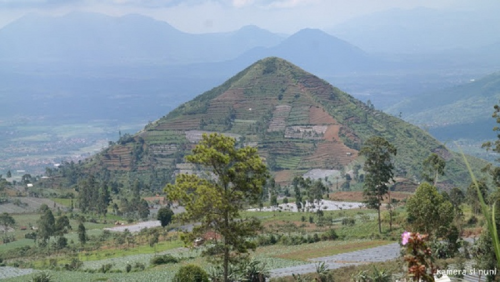If true, the claim could rewrite prehistory and shed light on an obscure yet powerful and advanced ancient civilisation.
Geologist Dr Danny Hilman believes that a site in West Java is revered because it hides an ancient temple built between 9,000 and 20,000 years ago.
The Megalithic site of Gunung Padang was discovered in 1914 and is the largest site of its kind in Indonesia.
It is nestled among volcanoes, banana palms and tea plantations, at 2,903 ft (885 metres) above sea level some 75 miles (120km) south of Jakarta.
Chunks of volcanic rubble jut out up from the stepped hillside, which is considered sacred by the Sundanese people who live locally.
Geologist Dr Danny Hilman believes the site is culturally important is because it is an ancient pyramid which was built between 9,000 and 20,000 years ago.
He suggests that it may have been built for worship or astronomy.
If this is true, prehistoric people would have had to manoeuvre chunks of volcanic rock onto terraces built on the mountainside and stack them on top of each other to create a pyramid – a considerable feat of ancient engineering.
Dr Hilman, a senior geologist at Indonesia’s Centre for Geotechnical Research, says that proof of the structure’s organisation lies underground.
His excavations have been backed by the Indonesian government, which recently decreed that the upper part of Gunung Padang is 'the largest megalithic structure in south-east Asia,' The Sydney Morning Herald reported.
President Yudhoyono dubbed the dig a ‘task of history…of important value to humanity.' and it has yielded some ancient artefacts.
Dr Hilman said: ‘People think the prehistoric age was primitive, but this monument proves that wrong.’
He believes such a pyramid would be proof of an advanced ancient civilisation in Java and said that the majority of the stepped site is man-made, perhaps built by generations over a matter of centuries.
The geologist is now working to establish the authenticity of the site.
Some rocks were originally stuck together with a form of ancient glue and have been carbon dated to be around 7,000 BC.
Dr Hilman said that the ruins hide walls and rooms with steps and terraces below, which are evidence of a complex building.
The terraces are bordered by retaining walls of stone that can be accessed by 400 steps rising around 311 ft (95 metres).
The structure is covered with massive rectangular stones of volcanic origin.
It has been subjected to multiple geoelectric surveys, where ground penetrating radar and samples have been used.
From this, he believes the terraced hill is 328 ft (100 metres) thick and is made up of a number of layers.
He said that so far man-made structures have been detected 49 ft (15 metres) underground.
Experts dated rock between nine and 13 ft (three and four metres) below the surface as 6,500 years old and 12,500 years old below the surface.
However, Dr Hilman’s controversial findings are disputed and 34 Indonesian archaeologists and geologists have submitted a petition criticising the projects’ methods and motives.
They say that the excavation threatens the preservation of the site as it is and are annoyed at the prospect of involving civilian archaeologists in the excavation.
Volcanologist Sutikno Bronto believes that the structure isn’t a pyramid at all, but the neck of an old volcano and that the stones surveyed have been weathered by nature instead of being cut by humans.
Another anonymous expert is sceptical that such an ancient civilisation could have been advanced enough to build a pyramid so many thousands of years ago, when tools recovered from a nearby cave, dating to 7,000 BC were very primitive.

Egypt’s oldest pyramid was built almost 5,000 years ago but a similar structure hidden beneath rubble could be up to four times older.




